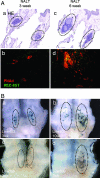Transgenic LacZ under control of Hec-6st regulatory sequences recapitulates endogenous gene expression on high endothelial venules
- PMID: 17360566
- PMCID: PMC1838643
- DOI: 10.1073/pnas.0700334104
Transgenic LacZ under control of Hec-6st regulatory sequences recapitulates endogenous gene expression on high endothelial venules
Abstract
Hec-6st is a highly specific high endothelial venule (HEV) gene that is crucial for regulating lymphocyte homing to lymph nodes (LN). The enzyme is also expressed in HEV-like vessels in tertiary lymphoid organs that form in chronic inflammation in autoimmunity, graft rejection, and microbial infection. Understanding the molecular nature of Hec-6st regulation is crucial for elucidating its function in development and disease. However, studies of HEV are limited because of the difficulties in isolating and maintaining the unique characteristics of these vessels in vitro. The novel pClasper yeast homologous recombination technique was used to isolate from a BAC clone a 60-kb DNA fragment that included the Hec-6st (Chst4) gene with flanking sequences. Transgenic mice were generated with the beta-galactosidase (LacZ) reporter gene inserted in-frame in the exon II of Hec-6st within the isolated BAC DNA fragment. LacZ was expressed specifically on HEV in LN, as indicated by its colocalization with peripheral node vascular addressin. LacZ was increased in nasal-associated lymphoid tissue during development and was reduced in LN and nasal-associated lymphoid tissue by LTbetaR-Ig (lymphotoxin-beta receptor human Ig fusion protein) treatment in a manner identical to the endogenous gene. The transgene was expressed at high levels in lymphoid accumulations with characteristics of tertiary lymphoid organs in the salivary glands of aged mice. Thus, the Hec-6s-LacZ construct faithfully reproduces Hec-6st tissue-specific expression and can be used in further studies to drive expression of reporter or effector genes, which could visualize or inhibit HEV in autoimmunity.
Conflict of interest statement
The authors declare no conflict of interest.
Figures





Similar articles
-
I kappa B kinase complex alpha kinase activity controls chemokine and high endothelial venule gene expression in lymph nodes and nasal-associated lymphoid tissue.J Immunol. 2004 Nov 15;173(10):6161-8. doi: 10.4049/jimmunol.173.10.6161. J Immunol. 2004. PMID: 15528353
-
Lymphotoxin plays a crucial role in the development and function of nasal-associated lymphoid tissue through regulation of chemokines and peripheral node addressin.Am J Pathol. 2005 Jan;166(1):135-46. doi: 10.1016/S0002-9440(10)62239-0. Am J Pathol. 2005. PMID: 15632007 Free PMC article.
-
Ectopic LT alpha beta directs lymphoid organ neogenesis with concomitant expression of peripheral node addressin and a HEV-restricted sulfotransferase.J Exp Med. 2003 May 5;197(9):1153-63. doi: 10.1084/jem.20021761. J Exp Med. 2003. PMID: 12732657 Free PMC article.
-
Understanding high endothelial venules: Lessons for cancer immunology.Oncoimmunology. 2015 May 7;4(6):e1008791. doi: 10.1080/2162402X.2015.1008791. eCollection 2015 Jun. Oncoimmunology. 2015. PMID: 26155419 Free PMC article. Review.
-
Lymphocyte 'homing' and chronic inflammation.Pathol Int. 2015 Jul;65(7):344-54. doi: 10.1111/pin.12294. Epub 2015 Apr 1. Pathol Int. 2015. PMID: 25831975 Review.
Cited by
-
High Endothelial Venules and Lymphatic Vessels in Tertiary Lymphoid Organs: Characteristics, Functions, and Regulation.Front Immunol. 2016 Nov 9;7:491. doi: 10.3389/fimmu.2016.00491. eCollection 2016. Front Immunol. 2016. PMID: 27881983 Free PMC article. Review.
-
Genetic engineering of a mouse: Dr. Frank Ruddle and somatic cell genetics.Yale J Biol Med. 2011 Jun;84(2):117-24. Yale J Biol Med. 2011. PMID: 21698043 Free PMC article. Review.
-
Lymphotoxin and TNF: how it all began-a tribute to the travelers.Cytokine Growth Factor Rev. 2014 Apr;25(2):83-9. doi: 10.1016/j.cytogfr.2014.02.001. Epub 2014 Feb 12. Cytokine Growth Factor Rev. 2014. PMID: 24636534 Free PMC article. Review.
-
Lymphotoxin-alpha contributes to lymphangiogenesis.Blood. 2010 Sep 23;116(12):2173-82. doi: 10.1182/blood-2009-12-256065. Epub 2010 Jun 21. Blood. 2010. PMID: 20566898 Free PMC article.
-
Conditional gene targeting in mouse high endothelial venules.J Immunol. 2009 May 1;182(9):5461-8. doi: 10.4049/jimmunol.0802327. J Immunol. 2009. PMID: 19380794 Free PMC article.
References
Publication types
MeSH terms
Substances
Grants and funding
LinkOut - more resources
Full Text Sources

